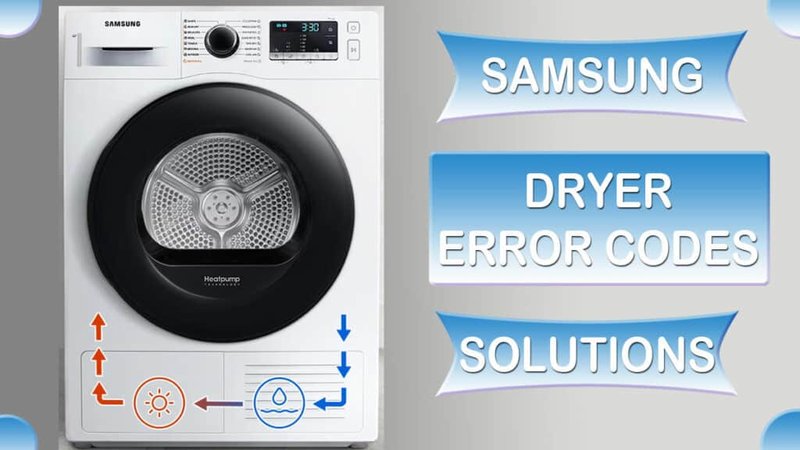
First things first, what exactly is the “OE” error code? In simple terms, it indicates that your dryer is experiencing a problem with its moisture sensor. This sensor is essential because it tells the dryer how damp or dry your clothes are, so it knows when to stop drying. It’s like the timer on your oven that tells you when the cookies are perfectly baked. When the sensor isn’t working correctly, the dryer might not shut off at the right time. This could mean your clothes end up too dry, potentially damaged, or, in a worst-case scenario, a fire hazard. Not exactly what you want when you’re just trying to dry clothes, right?
Understanding the “OE” Error Code
So, let’s break down the “OE” error in more detail. This error isn’t just some random glitch. The moisture sensor is a crucial part of your dryer’s functionality. Imagine trying to bake something without knowing the exact temperature or timing. It’s hit-or-miss, and that’s essentially what’s happening when this sensor fails. The “OE” code is the dryer’s way of waving a red flag!
When you see this code, it means the dryer isn’t properly detecting when your clothes are dry. The sensor might be faulty or dirty, or there could be a wiring issue. It’s similar to trying to measure water with a broken scale — the results just aren’t reliable. This error can lead to longer drying times as the machine attempts to get it right, which not only delays your laundry but also uses more energy, leading to higher utility bills. Furthermore, over-drying could damage delicate fabrics, causing shrinkage or wear and tear.
But here’s the silver lining: The “OE” error code is generally a safety feature, preventing more serious problems. Sure, it’s a hassle now, but it’s better than having a dryer that overheats your clothes, potentially setting the stage for more dangerous issues.
What Causes the “OE” Error?
Now, you might be curious about what actually causes this error to show up. There are a few common culprits. Dust and lint buildup is one. Just like when your air conditioner’s filter gets clogged, the build-up can affect how things function. If the sensors in your dryer get coated in lint, they can’t do their job correctly.
Another potential cause is a misaligned load. If you’ve ever tried to balance a stack of books on one side of a shelf, you know the instability it causes. Similarly, if your laundry load isn’t evenly distributed, it can overwhelm the sensor. This can confuse the dryer, making it think your clothes are still damp when they’re not.
Finally, wiring issues might be the hidden villain. As with any electronic device, wires can become loose or damaged over time. This can break the connection to the sensor, throwing things out of whack. It’s like trying to listen to your favorite radio station with a broken antenna — lots of static and frustration!
Steps to Fix the “OE” Error
So, what can you do if you encounter this error? Don’t worry; you don’t need to be an engineer to troubleshoot this. First, start by cleaning the moisture sensor. Check your user manual to find out exactly where it’s located. Usually, a damp cloth is enough to gently wipe away any lint or residue.
Next, assess how you load your dryer. Ensure that your clothes are evenly spread out. Think of it like arranging books on a shelf — balance is key. Avoid overloading, as this can also stress the sensor. If you’ve got a particularly large load, consider splitting it into two smaller, more manageable ones.
If these steps don’t resolve the issue, it might be time to call in a professional. You wouldn’t try to fix complex car issues without the right expertise, and the same goes for your dryer. An expert can safely check the wiring and replace any faulty parts, ensuring that your dryer runs smoothly and safely.
Is It Safe to Continue Using the Dryer?
Now that we’ve looked at the causes and fixes, the big question remains: Is it safe to use your Samsung dryer with the “OE” error code? While it might be tempting to just keep using it, it’s generally not advisable to continue operating the dryer without addressing the issue.
Continuing to use the dryer with this error could lead to inefficiencies and potentially cause more damage to the unit. Like driving a car with a flat tire, it’s just not a good idea. The risk of overheating or fabric damage is significant, and if the underlying issue is a wiring problem, it could pose a fire risk. It’s always better to err on the side of caution.
That said, if you absolutely must use your dryer before a repair can be made, be vigilant. Regularly check the load to ensure it’s not overheating, and don’t leave the dryer running unattended. Safety should always come first, so prioritize getting the error resolved before relying on the machine for regular use.
Preventative Tips
Finally, let’s talk about prevention. How can you avoid seeing the “OE” error in the future? Regular maintenance is key. Just as you’d regularly service your car, your dryer benefits from a little TLC. Clean the lint filter after each load to prevent buildup. Every few months, clean the moisture sensor with a soft, damp cloth to ensure it stays sensitive to humidity levels.
Also, consider the loads you’re putting into your dryer. Stick to the recommended capacity, and avoid cramming it full. A balanced, moderate load not only helps the sensor do its job but also prolongs the life of your machine.
By keeping your dryer in tip-top shape and being mindful of how you use it, you’ll reduce the chances of encountering errors like “OE.” And, if you do, you’ll know exactly what steps to take to get things back on track.